 |
 |
|
by Ben Simons
|
In the early twentieth century Nantucket's whaling wharves launched a generation of artists who transformed the island's identity from an economic hub dependent on the sea to a haven for the arts. The Nantucket art colony came to life in the 1920s among the shacks, shanties, boathouses, and other old buildings that were the relics of the island's long-vanished whaling past. Florence Lang, a Nantucket summer resident and native of Montclair, New Jersey, began converting many of these wharf shacks into studio spaces to rent to artists in the summer months. In 1924, she opened the Easy Street Gallery, converting an old cooper's shop into the island's first modern art gallery. Soon, a group of artists, known as the "waterfront artists," arrived to study with Frank Swift Chase, the painter and teacher who arrived in 1920 and would become the "dean of Nantucket artists."
Early exhibitions at the Easy Street Gallery were genteel affairs—only tea was served—in sharp contrast to the more politicized air of other contemporary art colonies. The Boston Herald reported: "Down in old Nantucket the Paradise has been established.... There are no bobbed and hennaed beauties, bare of knee and smocked of frock; there are no dawdlers and pretenders, no dabblers in batik or spouting, long-haired orators, who talk revolutionary ideas.... Artists on Nantucket are real people." The New York Herald-Tribune commented, "In Nantucket's art world, it appears, there is neither avarice nor politics."
text continued below...
|
|
 |
 |
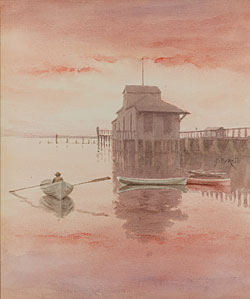 |
|
 |
|
Jane Brewster Reid (1862–1966), Rowboats, ca. 1910s. Watercolor on paper, 9 x 7-1/2 inches. Signed middle right. Collection of Max and Heidi Berry.
|
Jane Brewster Reid was a prolific watercolorist from Rochester, New York, who visited Nantucket as early as 1891, and continued to show her work on the island well into the 1930s. Her soft and endearing watercolors idealize many classic Nantucket settings and numerous 'Sconset houses. A transitional figure working before and during the establishment of the art colony, her early watercolors were included in Henry S. Wyer's 1902 booklet, Sea-Girt Nantucket. During the height of the colony, she advertised her work as "Miss Reid's Water Color Paintings/Nantucket Subjects" at Miss Sylvia's Shop, 16 Pleasant Street, and by 1938 was showing at the Swimming Duck, 40 Centre Street. Once Reid chose a favored setting, she often produced numerous copies of the same scene, occasionally varying the size. Her sketching expeditions covered the island, but she was especially drawn to the quaintness and romantic charm of 'Sconset.
|
|
 |
 |
 |
|
 |
|
Wuanita Smith (1866–1959), Stone Alley, ca. 1920s. White-line colored woodcut, 11 x 9 inches. Signed lower right corner. Collection of Max and Heidi Berry.
|
A native of Philadelphia, Pennsylvania, Wuanita Smith was a painter, printmaker, and illustrator of children's books. Smith studied at the Philadelphia School of Design for Women (now Moore College of Art), and cofounded the American Color Print Society of Philadelphia. A student of Howard Pyle at the Drexel Institute, she also studied at the Pennsylvania Academy of the Fine Arts, the Art Students League in New York, and in Paris with printmaker Allen Lewis. She was a part of the Provincetown, Massachusetts, group that developed the "white line" color block-print method, based on Japanese woodcut techniques, during World War I. She exhibited in Provincetown in the 1920s and 1930s, and also had a studio on Nantucket. She was also a regular exhibitor at the summer art colony in Rehoboth Beach, Delaware, as well as the Pennsylvania Academy, the Plastic Club, and the Woodmere Art Museum.
|
|
 |
 |
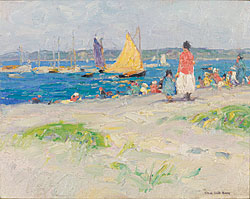 |
|
 |
|
Frank Swift Chase (1886–1958), Rainbow Fleet, ca. 1930s. Oil on canvas board, 8 x 10 inches. Signed lower right corner. Collection of the Nantucket Historical Association; gift of George S. Heyer Jr. in Honor of Niles D. Parker. 2006.18.1.
|
Known as the "dean" of the Nantucket artists, Frank Swift Chase served as the colony's master painter and teacher, offering en plein air "Classes in Landscape Painting" to a generation of artists. He was invited to Nantucket for the first time in 1920 by Margaret Underwood Davis, the owner of the Underwood Cottages on Hulbert Avenue, who was seeking art instruction. Except for 1935, when he painted the desert near Palm Springs, Chase taught every summer on Nantucket until 1955. A native of St. Louis, Missouri, he received his training under John Carlson and Birge Harrison at the Art Students League in New York City. He was also a founder of the Woodstock Artists Association and the Sarasota School of Art on Longboat Key.
Many of Chase's works are clearly painted in the field, with quick, expressive brushwork. He favored subdued grays, blues, lavenders, and browns, frequently employing the wet-into-wet technique he taught his students and using a heavily loaded brush and occasionally a palette knife, which created thick and choppy strokes. Chase showed his work regularly in the Easy Street Gallery shows in August, at the Candle House Gallery, at his studios, and, starting in 1945, at the Kenneth Taylor Galleries. Upon his death in 1958, the local Inquirer and Mirror eulogized the longtime guiding spirit of the art colony: "For many years his group of eager students benefited by his sound guidance, his encouragement, and his understanding of each individual's needs. His own painting had fine solidity and a poetic feeling for the beauty of nature."
|
|
 |
 |
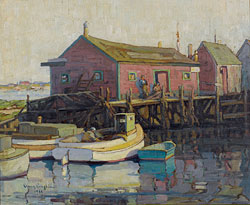 |
|
 |
|
Anne Ramsdell Congdon (1873–1958), Yerxa's Boat Shop, 1936, oil on canvas board, 32 x 37 inches. Signed and dated llc. Collection of Mr. and Mrs. Richard Congdon.
|
One of the finest talents of the art colony, Anne Ramsdell Congdon began her artistic career painting delicate watercolor landscapes during summer visits to the island with her Nantucket-native husband, Dr. Charles D. Congdon. After early studies in Paris, she trained with an assistant of William Merritt Chase before coming under the tutelage of Charles Woodbury in Boston and Perkins Cove (near Ogunquit, Maine). Woodbury's use of bold colors, choppy, open brushstrokes, and heavy diagonals would be a major influence on the development of Congdon's style prior to her work with Frank Swift Chase.
During a hiatus of over twenty years, she raised her two sons and managed an antiques shop in her hometown of Nashua, New Hampshire. Congdon returned to painting on Nantucket in 1926, newly inspired by the burgeoning art colony. When her husband retired in 1930, the couple moved permanently to Nantucket. Congdon became a regular student of Frank Swift Chase. Her style developed from more thinly painted, smoothly finished works to heavily built-up canvases in which strong shading, sweeping blocks of color, and vigorous impasto were laid on with a charged brush or palette knife. Her typical subject matter was the waterfront wharves, the Creeks, and the range of open pastures, moors, ponds, and lonely farms that were scattered accross the island. Congdon exhibited regularly at the Easy Street Gallery through the 1940s, as well as showing periodically at the Hope Chest in 'Sconset and in Annie Alden Folger's shop on Union Street.
|
|
 |
 |
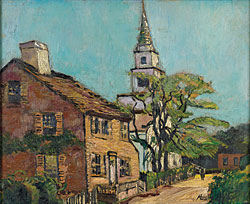 |
|
 |
|
Richard Hayley Lever (1876–1958), Summer Street, ca. 1936. Oil on board, 9-3/4 x 12 inches. Signed lower right corner. Collection of the Nantucket Historical Association; gift of the Friends of the Nantucket Historical Association. 1996.5.1.
|
Richard Hayley Lever influenced the development of modernism in American painting and was one of the most significant artists to visit and work in the Nantucket art colony, producing some of his finest work with Nantucket as his subject. Born in Adelaide, Australia, Lever studied in London and Paris before settling in the Cornish town of St. Ives, where he completed his series of brilliant seascapes in a distinctive style strongly influenced by the works of Vincent van Gogh. In 1911, Lever moved to New York, establishing himself as an artist and teacher at the Art Students League, where he associated with the modernists of the Ashcan School.
By 1915, Lever had acquired a summer home in Gloucester, Massachusetts, and may have been drawn to visit Nantucket around this time. Firmly established on Nantucket by 1928, he exhibited twelve paintings, of which at least eight were Nantucket scenes, at the Easy Street Gallery exhibition in 1929. Hampered by financial difficulties, and suffering from what he perceived as critical neglect and the diminished attention of major galleries and museums, Lever moved to Caldwell, New Jersey, and then to Mount Vernon, New York, where he became director of the Studio Art Club. He continued to struggle for recognition for the next two decades, until arthritis curtailed his artistic output.
|
|
 |
 |
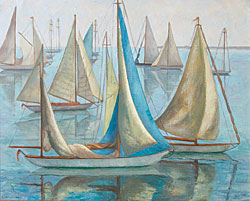 |
|
 |
|
Elizabeth Saltonstall (1900–1990), Peaceful Boats, ca. 1950. Oil on canvas, 24 x 30 inches. Signed lower left corner. Collection of Meredith and Eugene Clapp.
|
A master of the art of stone lithography, Elizabeth Saltonstall was also an accomplished painter in oils, watercolors, and, later, acrylics. Saltonstall studied at the School of the Museum of Fine Arts in Boston, and later under the tutelage of noted lithographer Stow Wengenroth in Maine. She taught art at Milton Academy for thirty-seven years, and always preferred to think of herself as an artist in residence rather than an instructor. Saltonstall came to Nantucket in 1922 to study with Frank Swift Chase, at first occupying a studio on Commercial Wharf before settling long-term into her studio and apartment known as Wateredge, at the base of the wharf. She returned to Wateredge every summer except one for the remainder of her life, exhibiting at the Easy Street Gallery, the Candle House Studio, and, after 1945, in the Artists Association's Kenneth Taylor Galleries.
On Nantucket, Saltonstall drew inspiration for her exquisite lithographs from the island's rich variety of flora. Other favorite subject matter included shells, mushrooms, ducks, and vignettes culled from her close observation of her natural surroundings. Her oil paintings typically feature waterfront scenes, often undertaken from the front deck of her cottage or from a nearby wharf. Although she occasionally broke up her summer with trips to Martha's Vineyard or Maine, and made several overseas expeditions, she always returned to her beloved Nantucket.
|
|
 |
text continued from above...
Shows at the Easy Street Gallery ran typically for the month of August, with exhibition rosters that included Frank Swift Chase and his remarkable corps of students, among them, Anne Ramsdell Congdon, Ruth Haviland Sutton, Emily Hoffmeier, Elizabeth Saltonstall, Isabelle Tuttle, Gertrude Monaghan, and Harriet Lord. Other significant talents such as Tony Sarg, Walter Gilman Page, Inna Garsoian, Henry S. Eddy, and Edgar Jenney, and prominent visiting artists like Richard Hayley Lever showed frequently. Hundreds of artists exhibited their work at the gallery during its twenty-year existence.
Although some artists lived away from the water, the true heart of the art colony was among the "waterfront artists," who developed a magical camaraderie and later played crucial roles in the future of arts organizations on Nantucket, including the Kenneth Taylor Galleries and the Artists Association of Nantucket. In the early 1940s, one of this corps, Ruth Haviland Sutton, purchased the Commercial Wharf property from Lang and carried on the practice of renting studio space to artists. Island Service Wharf continued to operate until its sale to Sherburne Associates in 1964.
|
|
    |
The Nantucket Art Colony, 19207–1945, an exhibition of the Nantucket Historical Association, is on display in the Peter Foulger Gallery of the Nantucket Whaling Museum through November 12, 2007. For more information, visit www.nha.org or call (508) 228-1894 x 0.
|
|
    |
Ben Simons is the Robyn and John Davis Curator of Collections for the Nantucket Historical Association, Nantucket, Massachusetts. He curated The Nantucket Art Colony,1920-1945 and is author of the forthcoming accompanying exhibition catalogue.
|
|
    |
 Download the Complete Article in PDF Format Download the Complete Article in PDF Format    Get Adobe Acrobat Reader Get Adobe Acrobat Reader
|

|
 |
 |
|
|